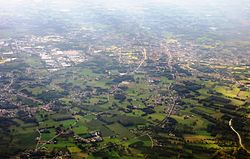Heist-op-den-Berg
| Heist-op-den-Berg | |||
|---|---|---|---|
| Municipality | |||
 |
|||
|
|||
| Location in Belgium | |||
| Coordinates: 51°05′N 04°43′E / 51.083°N 4.717°ECoordinates: 51°05′N 04°43′E / 51.083°N 4.717°E | |||
| Country | Belgium | ||
| Community | Flemish Community | ||
| Region | Flemish Region | ||
| Province | Antwerp | ||
| Arrondissement | Mechelen | ||
| Government | |||
| • Mayor | Luc Vleugels (CD&V) | ||
| • Governing party/ies | CD&V, sp.a, Open Vld | ||
| Area | |||
| • Total | 86.46 km2 (33.38 sq mi) | ||
| Population (1 January 2016) | |||
| • Total | 42,110 | ||
| • Density | 490/km2 (1,300/sq mi) | ||
| Postal codes | 2220-2223 | ||
| Area codes | 015, 014, 016, 03 | ||
| Website | www |
||
Heist-op-den-Berg (Dutch pronunciation: [ˌɦɛi̯st ɔb dɛm ˈbɛrx]) is a municipality located in the Belgian province of Antwerp. The municipality comprises Heist-op-den-Berg proper (including the hamlets: Heist-Goor, Heist-Station, Zonderschot, Heist-Centrum and Bruggeneinde), the villages of Booischot (including the hamlet Pijpelheide), Hallaar, Itegem, Schriek and Wiekevorst.
The 48-meter-high hill on which Heist would later be built (hence the adjunct name op-den-Berg meaning “on the hill”) was formed during the early part of the Ice age. As can be appreciated from the artifacts shown at the regional museum on the city’s main square, this area was already populated in prehistoric times. Soon after the Romans yielded this land to the invading Germanic peoples in the 3rd and 4th century, Christianization followed. The village of Itegem, located right on the Nete River, was most likely the first hamlet to be founded, as suggested by a document dating from 976. Chapels in Hallaar and Itegem were built in the 12th century. This century also marked the beginnings of the Duchy of Brabant, of which this whole area was a part.
Around the year 1200, a military fort was built at the current location of the Ter Laken castle, on Booischot’s territory. Schriek, which was founded in 1125, got its own chapel in 1260 while the main church at Heist was built in 1340. These two religious buildings were heavily damaged during the wars of religion around 1600. During most of the Middle Ages, agriculture was driving the economy and several huge farming domains were built, some of which still subsist today (e.g., Wimpelhoeve in Wiekevorst, traces of which date from the 12th century, and Pandoerenhoeve in Schriek, dating from 1624). During the 17th and 18th century, the miraculous wooden statue of the Virgin and Child in the Hallaar church became an object of pilgrimage.
...
Wikipedia




